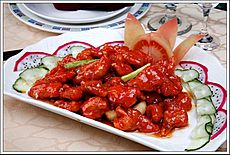Lychee pork facts for kids
 |
|
| Alternative names | Lizhi rou |
|---|---|
| Place of origin | China |
| Region or state | Fujian |
| Main ingredients | pork |
| Ingredients generally used | water chestnut, red wine lees |
Lychee pork or lizhi rou (Chinese: 荔枝肉; pinyin: lìzhī ròu; Eastern Min: liĕk-chiĕ-nṳ̆k) is one of the most well known dishes in Fujianese cuisine. Small pieces of deep-fried pork and sliced water chestnuts are served in a sweet and sour sauce. As is typical in Fujian, red yeast rice is used to add flavor and give a bright red color. The taste mixes sweet and sour, which is common in southern Chinese cuisine; the sauce is commonly made with ketchup, soy sauce and rice vinegar. Additional vegetable ingredients include yams, tomatoes, and green onions.
Origins in China
Lychee pork is a traditional dish in the cities of Fuzhou, Putian, and some southeastern areas of Fujian in China, dating back 200–300 years. It is highly representative of Min cuisine, known to be light but flavorful, soft, and tender, with a particular emphasis on the umami taste. Lychee pork is named so because the pork pieces curl up when cooked and are stained red, thus resembling lychee skins.
A legend includes one of the concubines of the Xuanzong Emperor of the Tang Dynasty, Consort Mei of the Jiang clan, whose hometown was Putian, Fujian. Because of the considerable distance from the Imperial Court to her hometown, she frequently grew homesick, and only lychees from her hometown could cure her despondency. She also employed a chef, Jiang (Chinese: 老蒋头; pinyin: lǎo jiǎng tóu), who devised an ingenious way of cooking meat so that it resembled one of these lychees. Although Consort Mei was killed in the Anshi Rebellion, the tradition goes that the chef escaped and fled back to Fujian, bringing it to the populace.
Lychee pork in the USA
Outside China, lychee pork forms the rudiments of some famous Chinese restaurant dishes. Chicken balls and pork balls are two familiar dishes that customers can order in North American Chinese restaurants. Two hundred years ago, the first group of Chinese from Guangdong and Fujian crossed the Pacific Ocean to the West Coast of America due to poverty in their hometowns and the prospect of work in the construction of American railroads. Due to the lack of integration into American society, the offspring of these immigrants opened up Chinese takeaways and restaurants, bringing the cooking skills from their hometown and modifying traditional southern Chinese cuisine (including lychee pork) to American cuisine to earn their living. Today, many similarities between lychee pork and chicken/pork balls can still be found.

